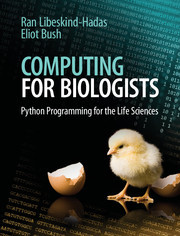Description
Computing for Biologists
Python Programming and Principles
Authors: Libeskind-Hadas Ran, Bush Eliot
This book teaches life science students how to use Python programming and computational problem-solving in the context of compelling biological applications.
Language: English
Subject for Computing for Biologists:
51.36 €
In Print (Delivery period: 14 days).
Add to cart
Computing for Biologists
Publication date: 09-2014
218 p. · 19x24.7 cm · Paperback
Publication date: 09-2014
218 p. · 19x24.7 cm · Paperback
Approximative price 76.05 €
Replenishment in progress
Add to cart
Computing for Biologists
Publication date: 09-2014
217 p. · 19.4x25.5 cm · Hardback
Publication date: 09-2014
217 p. · 19.4x25.5 cm · Hardback
Description
/li>Contents
/li>Biography
/li>
Computing is revolutionizing the practice of biology. This book, which assumes no prior computing experience, provides students with the tools to write their own Python programs and to understand fundamental concepts in computational biology and bioinformatics. Each major part of the book begins with a compelling biological question, followed by the algorithmic ideas and programming tools necessary to explore it: the origins of pathogenicity are examined using gene finding, the evolutionary history of sex determination systems is studied using sequence alignment, and the origin of modern humans is addressed using phylogenetic methods. In addition to providing general programming skills, this book explores the design of efficient algorithms, simulation, NP-hardness, and the maximum likelihood method, among other key concepts and methods. Easy-to-read and designed to equip students with the skills to write programs for solving a range of biological problems, the book is accompanied by numerous programming exercises, available at www.cs.hmc.edu/CFB.
Preface; Meet python; Part I. Python versus Pathogens: 1. Computing GC content; 2. Pathogenicity islands; 3. Open reading frames and genes; 4. Finding genes (at last!); Part II. Sequence Alignment and Sex Determination: 5. Recursion; 6. The use-it-or-lose-it principle; 7. Dictionaries, memoization, and speed; 8. Sequence alignments and the evolution of sex chromosomes; Part III. Phylogenetic Reconstruction and the Origin of Modern Humans: 9. Representing and working with trees; 10. Drawing trees; 11. The UPGMA algorithm; Part IV. Additional Topics: 12. RNA secondary structure prediction; 13. Gene regulatory networks and the maximum likelihood method; 14. Birds, bees, and genetic algorithms; Where to go from here; Index.
Ran Libeskind-Hadas is the R. Michael Shanahan Professor of Computer Science at Harvey Mudd College, USA, working in the areas of algorithms and computational biology. He is a recipient of both the Iris and Howard Critchell Professorship and the Joseph B. Platt Professorship for teaching, as well as the Distinguished Alumni Educator Award from the University of Illinois, Urbana-Champaign Department of Computer Science.
Eliot Bush is Associate Professor of Biology at Harvey Mudd College, USA. His main research interest is the study of evolution. Among other things he has modeled the evolution of metabolism, characterized DNA methylation patterns in insects, developed algorithms for studying substitution bias in DNA, and analyzed a 30-million-year-old primate fossil. His teaching interests focus on incorporating computers and programming assignments into biology coursework.
Eliot Bush is Associate Professor of Biology at Harvey Mudd College, USA. His main research interest is the study of evolution. Among other things he has modeled the evolution of metabolism, characterized DNA methylation patterns in insects, developed algorithms for studying substitution bias in DNA, and analyzed a 30-million-year-old primate fossil. His teaching interests focus on incorporating computers and programming assignments into biology coursework.
© 2024 LAVOISIER S.A.S.

